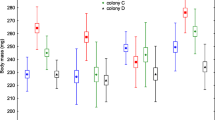Abstract
Tolerance to and biological consequences of hypothermia of queen honeybees are studied. Sequence of their responses to hypothermia is traced and resistance to freezing is determined. There is revealed an effect upon reproductive function of cooling to the state close to freezing.
Similar content being viewed by others
REFERENCES
Lozina-Lozinsky, L.K., tiOcherki po kriobiologii. Adaptatsiya i ustoichivostí organizmov i kletok k nizkim i sverkhnizkim temperaturam (Essays on Cryobiology. Adaptation and Resistance of Organisms and Cells to Low and Extralow Temperature), Leningrad, 1972.
Ushatinskaya, R.S., tiOsnovy kholodostoikosti nasekomykh (Bases for Cold Resistance of Insects), Moscow, 1957.
Masahito, T. and Takagiri, C., How Drosophila Species Acquire Cold Tolerance. Qualitative Changes of Phospholipids, Eur. J. Biochem., 1998, vol. 252, pp. 608–611.
Olsen, T.M., Sass, S.J., Li, N., and Duman, J.G., Factors Contributing to Seasonal Increases in Inoculative Freezing Resistance in Overwintering Firecolored Beetle Larvae Dendroides canadiensis (Pyrocroidae), J. Exp. Biol., 1998, vol. 201, pp. 1585–1594.
Somme, L., The Physiology of Cold Hardiness in Terrestrial Arthropods, Eur. J. Entomol., 1999, vol. 96, pp. 1–10.
Vemon, P. and Vanner, G., Developmental Patterns of Supercooling Capacity in Subantarctic Wingless Fly, Experientia, 1996, vol. 52, pp. 152–158.
Wordland, M.R., Sinclair, B.J., and Wharton, D.A., Ice Nucleator Activity in a New Zealand Alpine Cockroach Celatoblatta quinquemaculata (Dictyoptera: Blattidae), Cryo-Lett., 1977, vol. 18, no. 6, pp. 327–334.
Esíkov, E.K., Temperature of Maximal Supercooling in Honeybees and Its Phylogenetic Specificity, Izv. Akad. Nauk SSSR, Ser. Biol., 1984, pp. 535–542.
Esíkov, E.K. and Babkina, N.G., Age-Related and Seasonal Variability of Individual Resistance of the Honeybee Apis mellifera (Hymenoptera, Apidae) to Extremal Temperatures, Entomol. Obozr., 1990, no. 3, pp. 481–486.
Esíkov, E.K., tiEtologiya medonosnoi pchely (Etology of the Honeybee), Moscow, 1992.
Kakpakov, V.T., Perspectives of Foundation of the Russian Genome Bank, Konservatsiya geneticheskikh resursov (Conservation of Genetical Resources), Pushchino, 1996, pp. 34–36.
Skirkyavichyus, A.V., tiFeromonnaya kommunikatsiya nasekomykh (Pheromonic Communication of Insects), Vilnius, 1986.
Author information
Authors and Affiliations
Rights and permissions
About this article
Cite this article
Es'kov, E.K. Physiological Effects of Hypothermia on Queen Honeybees Apis mellifera . Journal of Evolutionary Biochemistry and Physiology 40, 277–281 (2004). https://doi.org/10.1023/B:JOEY.0000042631.01033.26
Issue Date:
DOI: https://doi.org/10.1023/B:JOEY.0000042631.01033.26




